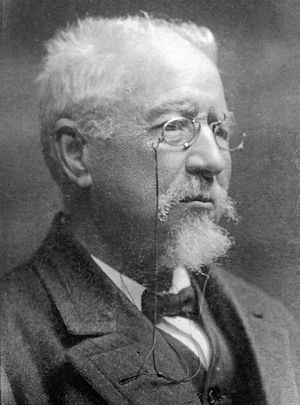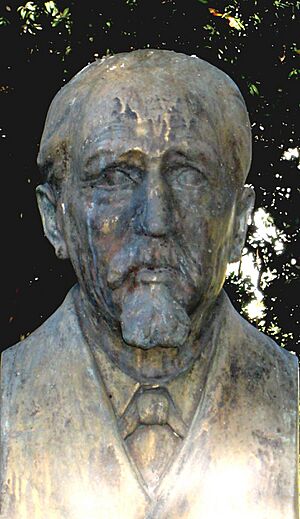Manuel Murguía facts for kids
Quick facts for kids
Manuel Murguia
|
|
|---|---|
 |
|
| Born | Manuel Antonio Martínez Murguía 17 May 1833 Arteixo (A Coruña), Spain |
| Died | 2 February 1923 (aged 89) A Coruña, Spain |
| Language | Galician, Spanish |
| Citizenship | Spanish |
| Spouse | Rosalía de Castro |
| Signature | |
 |
|
Manuel Antonio Martínez Murguía (born May 17, 1833 – died February 2, 1923) was an important Galician journalist and historian. He is famous for starting the Real Academia Galega, which is like the official language academy for Galician. He was also a key person in the Rexurdimento movement. This movement was a big revival of Galician culture and language. Manuel Murguía is also well-known as the husband, publisher, and main supporter of the famous poet Rosalía de Castro.
Contents
Manuel Murguía's Life Story
Manuel Murguía was born on May 17, 1833, in Arteixo, a town in Galicia, Spain. His father worked as a chemist.
Early Life and Influences
When Manuel was a child in A Coruña, he saw a big event. On April 23, 1846, local people fought against the central government. This fight ended with some people, known as the Mártires de Carral, being executed. This event deeply affected young Manuel. He later wrote about it in his article La Voz de Galicia.
Manuel Murguía studied philosophy and pharmacy in Santiago de Compostela. His father wanted him to be a pharmacist. However, Manuel loved literature and history much more. He decided to stop his studies to become a writer and researcher. He often visited the Liceo de la Juventud, a cultural center in Santiago. There, he met other students and thinkers, including Eduardo Pondal, Aurelio Aguirre, and Rosalía de Castro.
Starting His Writing Career
On June 1, 1854, Murguía published his first work in the Galician language. It was called Nena das Soidades (Girl of Loneliness). After this, he started working as a writer for journals and magazines. He became quite successful. He published other works like Mi madre Antonia (My mother, Antonia) and El Ángel de la Muerte (Angel of Death). He quickly became one of the most promising writers of his time.
Marriage and Historical Work
Murguía moved to Madrid. There, he became friends with writers like Gustavo Adolfo Bécquer. He also started a romantic relationship with Rosalía de Castro. They got married in Madrid on October 10, 1858. From the very beginning, Murguía strongly encouraged Rosalía's writing. He also helped her publish her books. Rosalía de Castro's book Cantares Gallegos is seen as the start of the Rexurdimento (Galician literature renaissance).
After achieving success as a creative writer, Murguía changed his focus. He began working full-time on historical research. He also worked to share his political ideas with more people. This was a very important step for the Rexurdimento movement.
When his first daughter was born, Murguía published La Primera Luz (The First Light). This book was for schools and covered history and geography. The Spanish government even suggested using this book to teach in schools in Galicia.
Later Life and Achievements
Murguía published many important works. One was Diccionario de escritores gallegos (Dictionary of Galician writers) in 1862. He then moved to Lugo in 1865. There, he published Historia de Galicia (History of Galicia).
In 1870, he became the Chief of the Arquivo Xeral de Galicia (General Archives of Galicia). Fifteen years later, he became the Cronista Xeral do Reino (Feature Writer of the Kingdom). All this time, he continued to write and publish different works.
In 1890, Murguía became a co-editor of La Patria Gallega (Galicia Native Country). This journal was important because it included the first ideas of Galician nationalism.
When he was 72 years old, Murguía decided to create an Academy for the Galician Language. He shared his idea with other writers. They met at a bookstore in A Coruña called A Cova Céltica. This Galician Academy officially started on August 25, 1906. Murguía also wanted to create a dictionary for the Galician language. He felt that there weren't enough Galician words written down. He even said that his own work in Galician was limited because there was no dictionary.
Manuel Murguía passed away on February 2, 1923, in A Coruña.
Legacy and Recognition
In 1963, one hundred years after Cantares Gallegos was published, a special day was created. It was called the Día das Letras Galegas (Galician Literature Day). Since then, May 17 each year is dedicated to a different Galician writer. In 1963, it was dedicated to Rosalía de Castro. Later, in 2000, Manuel Murguía's work was honored when the Día das Letras Galegas was dedicated to him.
Manuel Murguía's Works
Manuel Murguía wrote many books and stories. Here are some of his most well-known works.
Books
- La primera luz, 1860. This was a school book about history and geography.
- Diccionario de escritores gallegos, 1862. A dictionary of Galician writers.
- Historia de Galicia, published in several parts from 1865 to 1911. This was a major history of Galicia.
- Los Precursores, 1886. This book talked about important people who came before him.
- Galicia, 1888. A book about Galicia.
- El regionalismo gallego, 1889. About the idea of Galician regionalism.
- Los trovadores gallegos, 1905. About Galician poets from the past.
Tales
- Desde el cielo (novel), 1854.
- Mi madre Antonia, (novel), 1856.
- El ángel de la muerte, (novel), 1857.
Poetry
- "Nena d’as soledades" (poem), 1856.
- "Madrigal" (poem), 1856.
- "A las ruínas del Castillo de Altamira" (poem), 1856.
See also
 In Spanish: Manuel Murguía para niños
In Spanish: Manuel Murguía para niños


